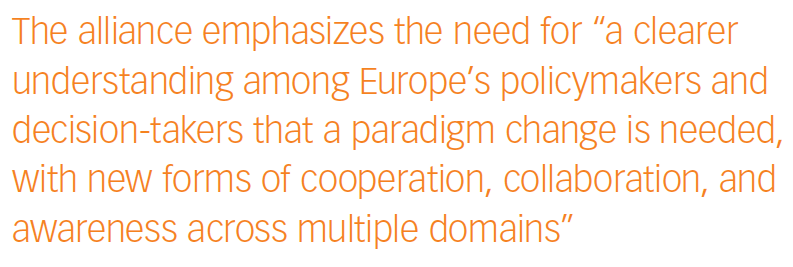Will Europe Turn a Corner in Personalized Medicine?
Pharmaceutical Executive
New action plan urges tighter alignment of public health policy with the development of targeted therapies.
A massive improvement in the health of Europe’s citizens is within reach, boldly asserted the European Alliance for Personalized Medicine (EAPM) on the eve of its conference in Belfast at the end of November. The ambitious claim is spelled out by EAPM across some 25 pages of a position paper released in advance, and is backed up by extensive arguments about the opportunities that targeted therapies can offer patients, health services, and society.
It is not the first time such a claim has been made in Europe. The rather halting European journey towards personalized medicine dates back more than a decade now, and a plethora of organizations have pitched their approaches to make it work.
Currently, a high-powered inter-governmental effort known as IC-PerMed is laboring toward establishing an action plan. The European Personalized Medicine Association is planning to fund scholarships in education and training of future healthcare professionals with a focus of using diagnostics and patient engagement and empowerment centered on personalized medicine. The private-public partnership of the Innovative Medicines Initiative is running a series of projects related to personalized medicine, including its ADAPT-SMART platform exploring how regulation can be better aligned to the development of targeted therapies. And Europe is still struggling to find ways of putting into effect the conclusions of ministers at the December 2015 health council to “take personalized medicine into account in the broader context of the future framework for sustainable European Union collaboration on patient safety and quality of care.”
The coalition mantra
What distinguishes this EAPM approach-as was noted by half-a-dozen members of the European Parliament in the foreword they have penned-is that the alliance is aiming to make a reality of building the frequently-evoked broad coalition among health stakeholders, a familiar slogan in any discussion of making progress in exploiting the wide-ranging scope of personalized medicine. The alliance emphasizes the need for “a clearer understanding among Europe’s policymakers and decision-takers that a paradigm change is needed, with new

forms of cooperation, collaboration, and awareness across multiple domains and stakeholders.”
EAPM has identified many of the barriers that need to be overcome to enable such a “paradigm change.” They include a limited evidence base; the absence of personalized healthcare in most cure pathways; a lack of consensus on clinical utility; varying standards and quality of provision; low awareness, particularly among healthcare professionals and patients; and insufficient coordination among policymakers and regulators.
The position paper deals in some detail with many of these challenges. But on one-and that is payment, the one that might be considered the biggest stumbling-block of all at present-it limits itself largely to generalizations: “Radical changes in thinking at the highest policy level in relation to public health generally will enhance the measurement of value for health interventions and adapt payment systems accordingly,” it states blithely. But will it, and how will it, and how soon will it?
Value dilemma plays on
In Europe, as in the US, one of the central elements of the personalized medicines debate-the issue of pricing-remains as challenging as ever. Everyone admits that the challenge exists, and particularly for the more expensive innovative products that are most likely to usher in new approaches to therapy. But admitting the challenge is only a first step toward finding solutions-and at the moment Europe is still very much at the first step.
The European Medicines Agency’s Guido Rasi warned last month that the speed of advance in the world of therapy is impeding planning. “It is absolutely impossible to predict what new technology will be inserted into the production system for medicines and therapies and the integrated systems that come with them,” he said. Italy is introducing a legislative framework for some form of postmarketing appraisal of new drugs in a bid to improve cost-effectiveness, but already there are questions over its criteria and methodology. Portugal has just updated its out-of-date 2006 framework for granting access to new drugs for rare diseases, but with little provision for better funding. Even in prosperous Germany, officials at its G-BA insurance organization recognize that the price of orphan drugs is too high in relation to extent of additional benefit, and are urging tighter controls.
If the authorities in Europe are aware of the problems from their side, drug firms operating here are even more acutely sensitive to deficiencies in the current arrangements. Pfizer complained in mid-November that Ireland is “one of the slowest countries in Europe” to fund the use of innovative medicines. Roche CEO Jens Grueger described to a recent conference the dilemma faced by companies developing multiple potential combinations involving new immunotherapies and personalized drugs. The healthcare systems and health technology assessment (HTA) bodies needed to assess the value of such innovations-and to make sure they are paid for so that patients can receive them-simply do not exist yet, he said.
Shire CEO Flemming Ornskov sees in the not-too-distant future the model shifting to outcomes-based payments, and “not just for rare diseases, but for all diseases.” But he told a recent conference in London that his excitement at that prospect was tempered by concerns over current European moves in a contrary direction: “What we are not excited about is an initiative to take some of these incentives away,” he warned. A senior official in the UK’s National Audit Office fretted in public over the ability of the National Health Service (NHS) to cope with change. Robert White, who is director for health value for money, said the rising costs of expensive, specialist drugs and medical devices are a concern and a worry for NHS sustainability. And Sir Andrew Dillon, head of the UK’s HTA body the National Institute for Health and Care Excellence (NICE), said recently that companies with expensive new technologies like CAR-Ts will need to work together with the NHS and think “more creatively” about payment structures.
In the US, pharma is enjoying some sunnier weather under the Trump administration, as more and more pro-industry (and often ex-industry) figures are appointed to senior posts and start to tweak the rules in the interests of drugmakers. Joe Grogan, associate director for health programs in the Office of Management and Budget, pushed back recently on a discount scheme that allows hospitals and health clinics to obtain cheaper medicines. He described it as “incredibly flawed,” and said the administration wants to explore new pricing mechanisms that could “create more freedom” for payers to seek creative deals with pharma companies. Otherwise, products like CAR-T drugs “will bankrupt the system and people can’t access them,” he said.
However, even there, companies are looking over their shoulders apprehensively at potential downsides from current tax reform proposals, which could hit foreign income from intellectual property wherever it is legally held, and threatens to remove or reduce tax credit for conducting clinical trials of rare disease drugs.
Answers, not advice
The comprehensive view of an effective strategy for drug innovation is conspicuous by its absence on both sides of the Atlantic. And EAPM, for all its vision, has little to offer in terms of solutions to the central dilemma of pricing. “National authorities, HTA bodies, and pricing and reimbursement agencies should be open to reconsidering how they get best value for patients and society out of public health spending,” it says. But “should” is easily said. More than that is needed to start to extricate pharma innovation from its currently closed circuit of frustration among drug developers and recrimination among those who pay for drugs.
Reflector is Pharmaceutical Executive’s correspondent in Brussels

FDA Grants Priority Review to Regeneron’s Eylea for Macular Edema Following Retinal Vein Occlusion
April 18th 2025Regulatory action was based on data from the Phase III QUASAR trial, which demonstrated that Eylea HD dosed every eight weeks achieved non-inferior visual acuity outcomes compared to Eylea in patients with macular edema following retinal vein occlusion.
Addressing Disparities in Psoriasis Trials: Takeda's Strategies for Inclusivity in Clinical Research
April 14th 2025LaShell Robinson, Head of Global Feasibility and Trial Equity at Takeda, speaks about the company's strategies to engage patients in underrepresented populations in its phase III psoriasis trials.
Study: GLP-1, SGLT2s Linked to Reduced Alzheimer Disease Risk in Patients with Type 2 Diabetes
April 17th 2025A new study found that patients with type 2 diabetes treated with GLP-1 receptor agonists and sodium-glucose cotransporter-2 inhibitors demonstrated lower risks of developing Alzheimer disease compared to other glucose-lowering drugs.
Key Findings of the NIAGARA and HIMALAYA Trials
November 8th 2024In this episode of the Pharmaceutical Executive podcast, Shubh Goel, head of immuno-oncology, gastrointestinal tumors, US oncology business unit, AstraZeneca, discusses the findings of the NIAGARA trial in bladder cancer and the significance of the five-year overall survival data from the HIMALAYA trial, particularly the long-term efficacy of the STRIDE regimen for unresectable liver cancer.